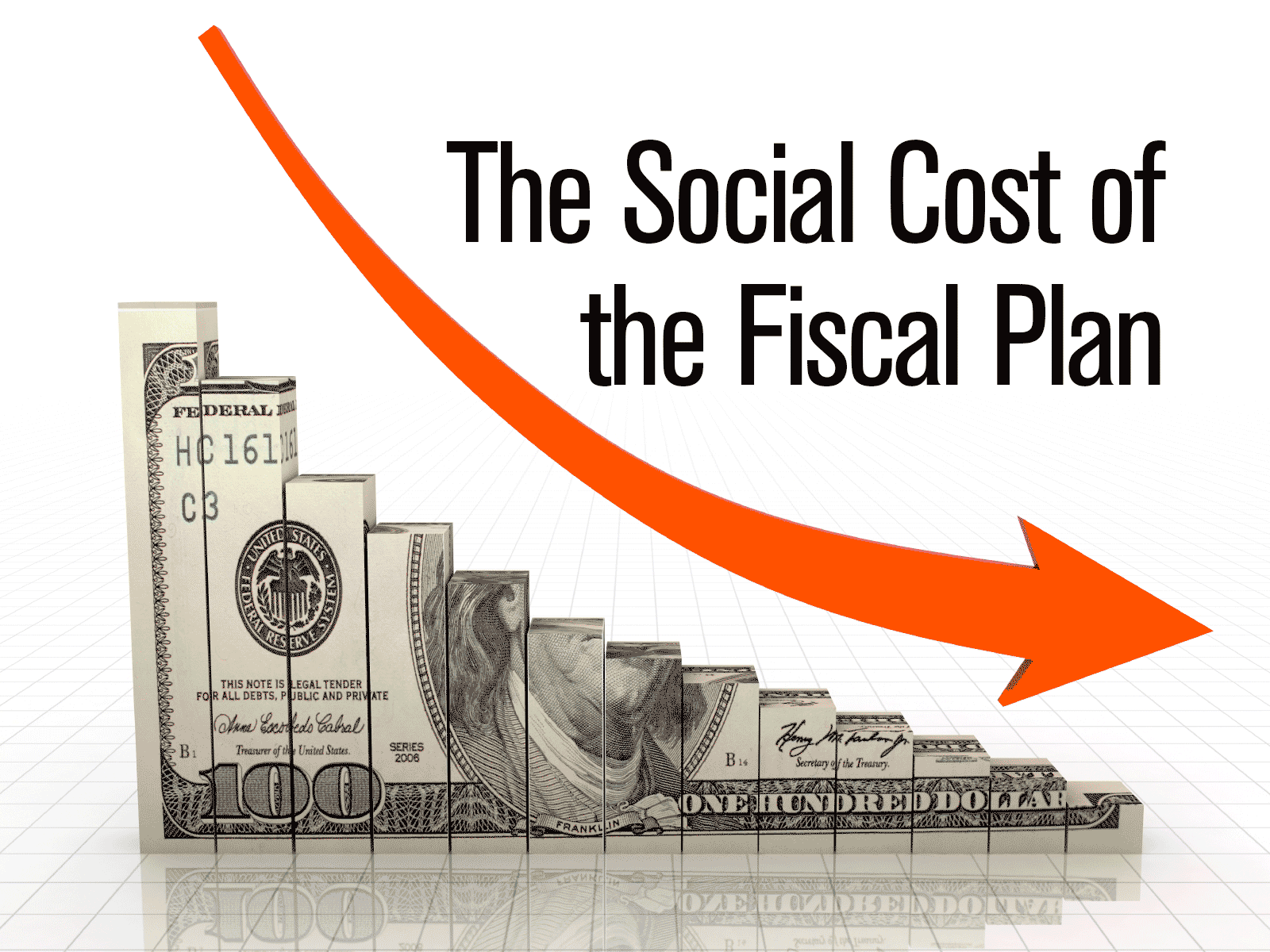
Policy Director
SHARE

On April 19, six members of the Fiscal Control Board (FCB) approved the Fiscal Plan for the government of Puerto Rico. In conceptual terms, the Plan consists of implementation of (1) a program of structural reforms; (2) a fiscal consolidation program; and (3) a reconstruction program financed by the federal government.
The Plan’s logic is the following: The spending related to the recovery from Hurricane Maria will temporarily increase economic activity; that (projected) rebound in the economy is the right time to implement a fiscal austerity plan, which will have a modest negative impact on the economy (according to the FCB); and concurrently implement a series of structural reforms that will serve as the foundation for long-term growth once the reconstruction ends and the negative impact of fiscal austerity has been assimilated by the economy. The Plan, therefore, is firmly anchored in a theory of macroeconomic adjustment that has failed in dozens of countries. The Board should be intellectually honest and admit that the document it has certified is more an ideological manifesto than a fiscal recovery plan.
The Plan, therefore, is firmly anchored in a theory of macroeconomic adjustment that has failed in dozens of countries.
The Plan has many defects. For example, it is not clear that it meets all the requirements stipulated in Section 201 (b) of PROMESA; it is based on theoretical assumptions that even the International Monetary Fund has found to be erroneous; the projections of the economic impact of the proposed reforms are the product of a secret economic model (footnote 3, page 10); the Plan seems to underestimate the negative impact of the fiscal reform and overestimate the positive impact of the structural reforms; it is internally incoherent, since the projections of primary surpluses are inconsistent with the Board’s debt sustainability analysis and suggest that Puerto Rico can sustain a level of indebtedness in excess of an average state of the union; and it assumes that the economy of Puerto Rico is going to continue to grow even with a permanent reduction in federal funds for Medicaid, the gradual reduction of funds for reconstruction, and a marked reduction in population, while at the same time it is generating a primary surplus of approximately two percent of the GNP. (Brad Setser, “The Oversight Board’s Latest Fiscal Plan for Puerto Rico is Still Too Optimistic”)
It all sounds overly optimistic. It probably is, and many economists and academics have already started to point out the Fiscal Plan’s shortcomings. But that is not what I want to write about today. Even if we accept the FCB’s projections and the Plan is followed to the letter, there are social costs associated with the Plan that are not being taken into consideration.
EDUCATION
Let’s start with the cuts to the Department of Education and the University of Puerto Rico. For more than sixty years, when Robert Solow began to calculate and isolate the factors that influence economic growth, investment in education has been identified as one of the key factors. I know of no country with an advanced economy that has managed to grow in any significant way at the same time it has reduced its investment in education. The proposed cuts, to both the K-12 system and the state university, will adversely affect access to education among the poorest sectors of Puerto Rico, resulting in an increase in the dropout rate and inequality, less access to the labor market, and a permanent reduction in our economy’s potential for growth. We could also see a reduction in Puerto Rico’s educational attainment for the first time in almost a hundred years.
LABOR REFORM
Let’s look now at labor reform. As presented in the Plan, the labor reform eliminates benefits and protections it considers “excessive” in exchange for a modest increase in the minimum wage. The Plan estimates that once the reform is implemented, the labor force participation rate will increase, incomes will rise, poverty will decrease, and the fiscal deficit will be reduced.
First, we would note that the FCB’s analysis is based on an erroneous interpretation of the labor force participation rate. (page 34) That indicator is calculated by adding the number of persons employed to the number of persons who are actively seeking employment, and then that number is divided by the economically active population, which is defined as the group of persons between 16 and 64 years of age. Therefore, it is not necessarily correct that an increase in the rate of participation means that there are more people employed. The participation rate can also improve if the number of persons unemployed and actively seeking employment increases, which has no impact whatsoever on income and poverty levels.
Second, it is not correct to assume that a modestly higher salary compensates for the loss of other benefits and labor-rights protections. Every labor law or regulation protects employees from a specific risk (unjustified dismissal, dangerous working conditions, etc.) that are not necessarily compensated for in a linear way with a small increase in the minimum wage.
In the short and medium term, the most probable effect of this labor reform will be an increase in the informal economy because jobs in the formal economy become relatively less attractive and we can expect workers already earning the minimum wage or those with weak ties to the formal labor market to prefer to be paid “off-the-books.” And the projected increase in government revenues due to the impact of this reform will be nothing more than an exercise in magical thinking.
NUTRITIONAL ASSISTANCE PROGRAM (PAN)
Another reform that has not been sufficiently thought out is to impose the requirement on certain persons between 18 and 59 years of age who benefit from the Nutritional Assistance Program (PAN) to work a minimum of 80 hours a month or take part in training activities or volunteer services. This is a classist, prejudiced policy that assumes that poor people are poor because they want to be, because they’re lazy, or because they suffer from some moral defect. This view of the world does not take into account the systemic impediments that limit access to the labor market, such as a poor educational system, the lack of a reliable system of public transportation, the limited offering of satisfactory childcare services, discrimination, racism, sexism, and social inequality.
Given that these individuals will have to work in order not to lose their benefits, many of the jobs that will be immediately available to this group will be jobs with low salaries, few or no fringe benefits, and irregular hours. Let’s take the case of a single mother with two children in public school. To avoid losing her PAN benefits, she gets a job in a megastore. In theory, she could work up to 40 hours a week. But actually, her supervisor can assign her 25 hours one week, 18 the next, and 10 hours the next. This person, then, could wind up losing her benefits despite the fact that she’s working.
Now let’s look at the example of a full-time university student who has to quit his studies to take care of his father, who is gravely ill. The young man applies for PAN benefits in order to nourish himself adequately while he’s serving as his father’s caretaker. But the ADSEF official informs him that he has to meet the requirement of 80 hours of work a month. What is this young man supposed to do? Leave his father alone for 80 hours a month while he complies with the program’s requirements? What if he leaves his father alone and the old man has an accident at home and the paramedic who comes to take care of him reports the young man for senior abuse?
Being poor is complicated. And hard to understand for a person who’s never been poor.
PENSION SYSTEM
The reform of the pension system is another area in which social costs have not been taken into account. The fiscal plan requires a cut of ten percent, on average, to retirees’ benefits. These cuts are based on the following formula: (1) the average monthly amount of the pension is determined by taking the sum of the monthly amount of the regular pension and the pension from “special laws,” the contribution to the medical plan, and one-twelfth of the Christmas and medicine bonuses; (2) those monthly benefits are reduced by 25%; and (3) and $150 is added to that amount (or $250 if the retiree does not receive Social Security) to reduce the impact on those with the lowest benefits. (Footnote 159, page 112)
If we apply this formula to a retiree who receives the “average” pension of $1,100 a month from the Employees Retirement System and the “average” monthly Social Security benefit in Puerto Rico of $859, the pensioner’s total income would be reduced from $1,959 per month to $1,468 (a reduction of 25%) plus $150, which adds up to an adjusted monthly pension payment of $1,819—a monthly reduction of $339, or 17.3%. Confronted with this situation, the “average” retiree would have to find a part-time job, if he or she is able to work, or cut his or her personal expenses, probably mostly medicines or food, or ask for help from his or her family members, who could help to the extent they themselves are able. At any rate, the life of the “average retiree” has been precarized due to the reduction in his or her pension. The social effects are foreseeable: chronic illnesses become acute when spending on medicines is cut, increases in the poverty rate and malnutrition among the elderly segment of the population, there is an increase in people postponing retirement and in the number of people who literally die working, an increase in the abandonment of the elderly and an eventual decline in life expectancy.
HEALTH
It is the area of health where the social costs of the Fiscal Plan are perhaps most underestimated. The Fiscal Plan projects savings of $840 million per year in 2023 in the cost of the government health plan, largely through the implementation of a new competition model among insurers, the use of generic medicines, and cuts in “premium” benefits such as dental, ophthalmological, and prosthesis-design services. Leaving aside the fact that economists have determined that competition in medical services has worked neither to reduce costs nor increase access, the impact of these cuts will adversely affect the health of the most vulnerable in our society: children, the elderly, the unemployed, and those with chronic diseases. The most probable consequences are an increase in migration to the mainland U.S., especially among those who qualify for Medicaid, Medicare, or both; overcrowding in hospitals; an increase in premature deaths and eventually a decrease in life expectancy.
LAST COMMENTS…
The six members of the Board who approved the Plan believe, despite all evidence to the contrary, that Puerto Rico will become a neoliberal paradise. That is highly unlikely. More likely is that we wind up with a hellish dystopia: more social polarization, unemployment, extreme poverty, crime, child abuse, gender violence, abuse of controlled-substance and suicides, and lower educational levels, life expectancy, and social mobility.
We will probably see geographical areas in ruins, with closed schools and abandoned buildings turned into “shooting galleries” for drug addicts and lairs of prostitution or improvised shelters for the homeless and the elderly without resources. Within a decade we could become a post-industrial wasteland in which the highest-growth activities will be drug trafficking, public corruption, and influence peddling. An island, paraphrasing Rubén Blades, inhabited mostly by ghosts and the living dead, who for some strange reason refuse to go anywhere else.
The original Spanish version was published in El Nuevo Día on April 28th, 2018.
